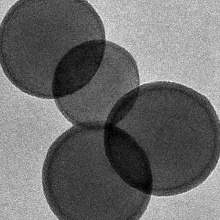What is the focus of our research?
The aim of research into Particle-based Functional Materials is the development of function-optimized materials for various applications in the fields of environmental protection (exhaust gas catalysis) and energy conversion (for example, hydrogen production, fuel cells). This will be done on the basis of a common technology platform, which consists of a combination of different synthesis and functionalization methods, supplemented with suitable online measurement methods for the characterization of structure and function. On this basis, it is possible to create a wide range of different structures and to optimize them in terms of their functionality to the desired application. Essential for achieving optimal functional properties is the knowledge of structure-function relationships from the level of nanostructured building blocks to macroscopic structures.
An essential element of the technology platform are synthesis methods that allow a high degree of control over structural properties and chemical composition on the nanometer scale and are also scalable. Two gas-phase methods have been studied and developed which fulfill these properties. An aerosol process is based on the chemical gas phase synthesis (CVS) of oxidic carrier particles and their coating with metals or oxides by chemical vapor deposition (CVD). The method allows a unique control of the structural properties such as size and surface texture of the carrier particles as well as size and number density of supported noble metal particles or layer thickness of oxidic shell structures. It is, thus, possible to create a variety of structures, from simple mixed oxides over supported metallic islands to core-shell structures and even Janus particles.
A plasma-based laboratory synthesis method, which also allows good control over structure and composition on the nanometer scale, is the so-called spark synthesis. This makes it possible to generate defined alloyed mixed metal nanoparticles, which is only possible indirectly or not at all with other methods.
At the level of nanostructured building blocks, the preservation of structural properties and, thus, the desired function is an important topic. In catalysis, the loss of active surface by sintering operations is a very big economic problem, especially when using precious metals. The stabilization of supported noble metals on oxidic carriers is, therefore, currently the subject of investigations in the research group. The goal is the identification of the factors influencing the sintering kinetics of metal particles on oxide surfaces and the development of stabilization strategies based on this knowledge.




